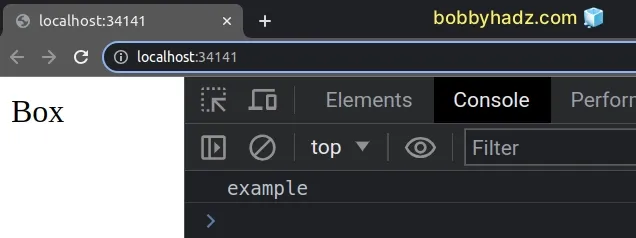TypeError: getAttribute is not a function in JavaScript
Last updated: Mar 3, 2024
Reading time·3 min

# TypeError: getAttribute is not a function in JavaScript
The "TypeError: getAttribute is not a function" error occurs for multiple reasons:
- Calling the
getAttributemethod on a jQuery object instead of a DOM element. - Calling the method on an object that is not a valid DOM element.
- Misspelling
getAttribute(it's case-sensitive). - Placing the JS script tag above the code that declares the DOM elements.

If you use jQuery, use the .attr method instead because a jQuery object
doesn't expose a getAttribute method.
// ✅ use `attr` instead of `getAttribute` const result = $('#box').attr('your-attribute'); console.log(result);
Here is an example of how the error occurs.
const obj = {}; // ⛔️ Uncaught TypeError: obj.getAttribute is not a function obj.getAttribute('data-test');
Calling the getAttribute method on an object that is not a valid DOM element causes the error.
# Only call getAttribute on valid DOM elements
Make sure to call the getAttribute() method on a valid DOM element and place
the JS script tag at the bottom of the body tag, after the DOM elements have
been declared.
<!DOCTYPE html> <html lang="en"> <head> <meta charset="UTF-8" /> </head> <body> <div id="box" data-test="example">Box</div> <!-- ✅ load jQuery ✅ --> <script src="https://code.jquery.com/jquery-3.6.0.min.js" integrity="sha256-/xUj+3OJU5yExlq6GSYGSHk7tPXikynS7ogEvDej/m4=" crossorigin="anonymous" ></script> <!-- ✅ Your JS script here ✅ --> <script src="index.js"></script> </body> </html>
Notice that the JS script tag must be placed at the bottom of the body, after
the DOM elements. Otherwise, we end up running the index.js file before the
DOM elements are created.
Here is the code for the index.js file.
const box = document.getElementById('box'); // 👇️ "example" console.log(box.getAttribute('data-test'));

Note that the getAttribute() method should only be called on valid DOM
elements.
If the error persists, make sure you haven't misspelled getAttribute() as it
is case-sensitive.
console.log the value you're calling the getAttribute method on and check if it's a valid DOM element.# Check if the element exists before calling getAttribute
If the element you're calling the method on sometimes doesn't exist,
conditionally check if the element is there before calling the getAttribute()
method.
For example, a basic DOM element has a type of object, so we can check if the
value is an object and contains the getAttribute() property before calling the
method.
const box = null; if ( typeof box === 'object' && box !== null && 'getAttribute' in box ) { console.log(box.getAttribute('data-test')); }
Our if condition uses the logical AND (&&) operator, so for the if block to
run, all conditions have to be met.
We first
check if the box variable stores a value with a type of object,
because DOM elements have a type of object.
Then we
check if the variable is not equal to null.
Unfortunately, if you check the type of null with console.log(typeof null),
you will get an "object" value back, so we have to make sure the value is not
null.
console.log(typeof null); // 👉️ object
getAttribute property.Then we know we can safely call the getAttribute() method on the object.
This approach is called duck-typing.
When using duck-typing, we simply check if the object implements specific properties or methods and if it does, we assume it's an object of the correct type.
# Conclusion
To solve the "getAttribute is not a function" error, make sure to call the
getAttribute() method on a valid DOM element and place the JS script tag at
the bottom of the body tag, after the DOM elements have been declared.
# Additional Resources
You can learn more about the related topics by checking out the following tutorials:
- How to check if an attribute exists using JavaScript
- Clear Img src attribute using JavaScript
- Copy all Styles/Attributes from one Element to Another in JS
- Create an Element with Attributes or Styles in JavaScript
- Access data-* attributes from the Event object in JavaScript
- Get DOM Element(s) by Attribute using JavaScript
- Get element(s) by data attribute using JavaScript
- Get Element(s) by their Name attribute using JavaScript
- Cannot read properties of null (reading 'getAttribute')

